 W
WVolga (Povolzhsky) economic region is one of 12 economic regions of Russia.
 W
WThe Volga Region is a historical region in Russia that encompasses the drainage basin of the Volga River, the longest river in Europe, in central and southern European Russia.
 W
WThe Akhtuba ; also transliterated Achtuba on some maps) is a left distributary of the Volga in southern Russia.
 W
WBulgaria was a class 785/OL800 Russian river cruise ship which operated in the Volga-Don basin. On 10 July 2011, Bulgaria sank in the Kuybyshev Reservoir of the Volga River near Syukeyevo, Kamsko-Ustyinsky District, Tatarstan, Russia, with 201 passengers and crew aboard when sailing from the town of Bolgar to the regional capital, Kazan. The catastrophe led to 122 confirmed deaths.
 W
WThe Belozersky Bypass Canal is a canal around the south-western part of Lake Beloye in Belozersky District of Vologda Oblast in north-western Russia. It connects Kovzha River to Sheksna River, and is part of the Volga–Baltic Waterway. The length of the canal is 66.8 kilometres (41.5 mi). The canal passes the town of Belozersk.
 W
WThe Moscow Canal, named the Moskva-Volga Canal until 1947, is a canal in Russia that connects the Moskva River with the Volga River. It is located in Moscow itself and in the Moscow Oblast. The canal connects to the Moskva River in Tushino, from which it runs approximately north to meet the Volga River in the town of Dubna, just upstream of the dam of the Ivankovo Reservoir. The length of the canal is 128.1 kilometres (79.6 mi).
 W
WLenin Volga–Don Shipping Canal is a broad ship canal that connects the Volga and the Don at their closest points. Opened in 1952, its length is 101 km (63 mi), 45 km (28 mi) of which is through rivers and reservoirs.
 W
WLake Beloye or White Lake, is a lake in the northwestern part of Vologda Oblast in Russia. Administratively, the lake is divided between Belozersky District (south) and Vashkinsky District (north) of Vologda Oblast. The town of Belozersk, is located on its coast. In terms of area, Lake Beloye is the second natural lake of Vologda Oblast, and the third lake also behind the Rybinsk Reservoir. It is one of the ten biggest natural lakes in Europe.
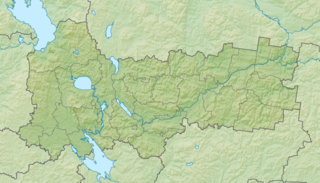 W
WLake Kovzhskoye is a freshwater lake, located in the center of Vytegorsky District of Vologda Oblast in Russia. It is one of the biggest lakes in Vologda Oblast and the second biggest one in Vytegorsky District behind Lake Onega. The area of the lake is 65 square kilometres (25 sq mi), and the area of its basin is 438 square kilometres (169 sq mi). The main tributary of the lake is the Iles River. Lake Kovzhskoye is the source of Kovzha River, one of the principal tributaries of Lake Beloye. The lake belongs to the basins of the Volga and the Caspian Sea.
 W
WLake Peno is a lake in Penovsky District of Tver Oblast, Russia. The Volga River flows through the lake in its upper course. The area of the lake is 16.7 square kilometres (6.4 sq mi).
 W
WSeliger is a lake in Ostashkovsky District of Tver Oblast and, in the extreme northern part, in Demyansky District of Novgorod Oblast of Russia, in the northwest of the Valdai Hills, a part of the Volga basin. It has the absolute height of 205 metres (673 ft), the area of 212 square kilometres (82 sq mi), and the average depth of 5.8 metres (19 ft).
 W
WLake Sterzh (Стерж) is the third largest among the Valdai Lakes in Tver Oblast of Russia. It is the first lake through which the Volga flows. The lake's length is 12 kilometres (7.5 mi), its width is up to 1,500 metres (4,900 ft), and the average depth is 5 metres (16 ft). The area of the lake is 17.9 square kilometres (6.9 sq mi). The lake gives its name to the Sterzh Cross.
 W
WLake Volgo is a lake in Ostashkovsky, Penovsky, and Selizharovsky Districts of Tver Oblast, Russia. The Volga River flows through the lake in its upper course. The area of the lake is 61 square kilometres (24 sq mi), and the area of its drainage basin is 3,500 square kilometres (1,400 sq mi). The urban-type settlement of Peno is located on the western bank of the lake.
 W
WLake Vselug is a lake in Penovsky District of Tver Oblast, Russia. The Volga River flows through the lake in its upper course. The area of the lake is 30.4 square kilometres (11.7 sq mi).
 W
WThe Zabolotye lake, the catchment area is 355 km2, the depth of the lake reaches to 5 meters. The banks are wooded.
 W
WCheboksary Reservoir is an artificial lake in the central part of the Volga River and formed by the Cheboksary Dam in Novocheboksarsk.
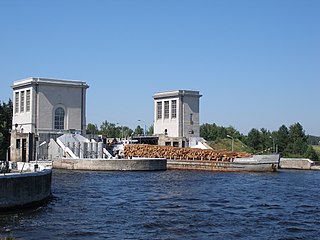 W
WGorky Reservoir, known colloquially as Gorky Sea, is an artificial lake in the central part of the Volga River formed by a hydroelectric dam of Gorky Hydroelectric Station built in 1955 between the towns of Gorodets and Zavolzhye and filled in 1955 – 1957. It spans for 430 km from the dam of Rybinsk to the dam of Gorodets through Yaroslavl, Kostroma, Ivanovo and Nizhny Novgorod oblasts of Russia. While it is relatively narrow and follows the natural riverbed of Volga in the upper part, it becomes up to 16 km wide downstream the town of Yuryevets.
 W
WIvankovo Reservoir or Ivankovskoye Reservoir, informally known as the Moscow Sea, is the uppermost reservoir on the Volga, in Moscow and Tver Oblasts of Russia, located some 130 km (81 mi) north of Moscow. The dam of the reservoir is situated in the town of Dubna. The town of Konakovo is located on its southern coast. The reservoir is connected to the Moskva by the Moscow Canal, and is the principal fresh water source for the city of Moscow. Its area is 327 km2 (126 sq mi), and the area of its drainage basin is 41,000 km2 (16,000 sq mi).
 W
WKuybyshev Reservoir or Kuybyshevskoye Reservoir, sometimes called Samara Reservoir and informally called Kuybyshev Sea, is a reservoir of the middle Volga and lower Kama in the Chuvash Republic, Mari El Republic, Republic of Tatarstan, Samara Oblast and Ulyanovsk Oblast, Russia. The Kuybyshev Reservoir has a surface area of 6,450 km² and a volume of 58 billion cubic meters. It is the largest reservoir in Europe and third in the world by surface area. The major cities of Kazan, Ulyanovsk, and Tolyatti are adjacent to the reservoir.
 W
WRybinsk Reservoir, informally called the Rybinsk Sea, is a water reservoir on the Volga River and its tributaries Sheksna and Mologa, formed by Rybinsk Hydroelectric Station dam, located in the Tver, Vologda, and Yaroslavl Oblasts. At the time of its construction, it was the largest man-made body of water on Earth. It is the northernmost point of the Volga. The Volga-Baltic Waterway starts from there. The principal ports are Cherepovets in Vologda Oblast and Vesyegonsk in Tver Oblast.
 W
WSaratov Reservoir is an artificial lake in the lower part of the Volga River in Russia formed by the dam of the Saratov Hydroelectric Station situated in the city of Balakovo. Filling of the reservoir started in 1967. The uppermost point of the reservoir is situated in Tolyatti, it stretches through Samara Oblast and Saratov Oblast. The city of Samara and the Samara Bend are situated on the reservoir. The namesake city of Saratov is situated downstream from the dam.
 W
WThe Sheknsna Reservoir or the Sheksninskoe Reservoir is a water reservoir on Sheksna River and Lake Beloye, in Belozersky, Vashkinsky, Kirillovsky, and Sheksninsky Districts of Vologda Oblast in Russia. The reservoir is formed by the dam of the Sheksna Hydropower Plant, located in the urban-type settlement of Sheksna.
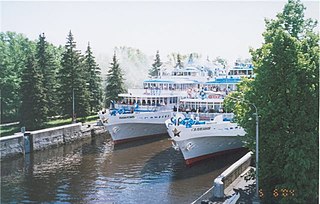 W
WUglich Reservoir or Uglichskoye Reservoir is an artificial lake in the upper part of the Volga River formed by the Uglich Hydroelectric Station dam.
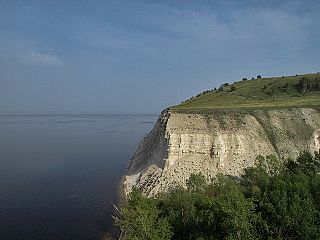 W
WThe Volgograd Reservoir is a reservoir in Russia formed at the Volga River by the dam of the Volga Hydroelectric Station. It lies within the Volgograd Oblast and Saratov Oblast and named after the city of Volgograd. It was constructed during 1958–1961.
 W
WTransvolga Region or Transvolga is a territory to the East of Volga River bounded by Volga, Ural Mountains, Northern Ridge, and Caspian Depression.
 W
WThe Valdai Hills are an upland region in the north-west of central Russia running north–south, about midway between Saint Petersburg and Moscow, spanning Leningrad, Novgorod, Tver, Pskov, and Smolensk Oblasts.
 W
WThe Volga Delta is the largest river delta in Europe, and occurs where Europe's largest river system, the Volga River, drains into the Caspian Sea in Russia's Astrakhan Oblast, north-east of the republic of Kalmykia. The delta is located in the Caspian Depression—the far eastern part of the delta lies in Kazakhstan. The delta drains into the Caspian approximately 60 km downstream from the city of Astrakhan.
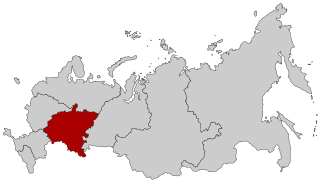 W
WVolga (Privolzhsky) Federal District is one of the eight federal districts of Russia. It forms the southeastern part of European Russia. Its population was 29,899,699 according to the 2010 Census, living on an area of 1,038,000 square kilometers (401,000 sq mi). Igor Komarov was appointed the federal district's Presidential Envoy on 18 September 2018.The historical center of the district is known as the Idel-Ural region.
 W
WThe Volga Upland, also known as the Volga Uplands, Volga Plateau, Volga Hills, or Volga Plateau, is a vast region of the East European Plain in the European part of Russia that lies west of the Volga River and east of the Central Russian Upland. The uplands run for approximately 800 kilometres (500 mi) in a southwest-northeasterly direction from Volgograd to Kazan. The Tsimlyansk Reservoir lies at the southwestern end of the Volga Upland, with the Kuybyshev Reservoir at the northeastern end.
 W
WThe Volga–Baltic Waterway, formerly known as the Mariinsk Canal System, is a series of canals and rivers in Russia which link the Volga with the Baltic Sea via the Neva. Like the Volga–Don Canal, it connects the biggest lake on Earth, the Caspian Sea, to the World Ocean. Its overall length between Cherepovets and Lake Onega is 368 kilometres (229 mi).